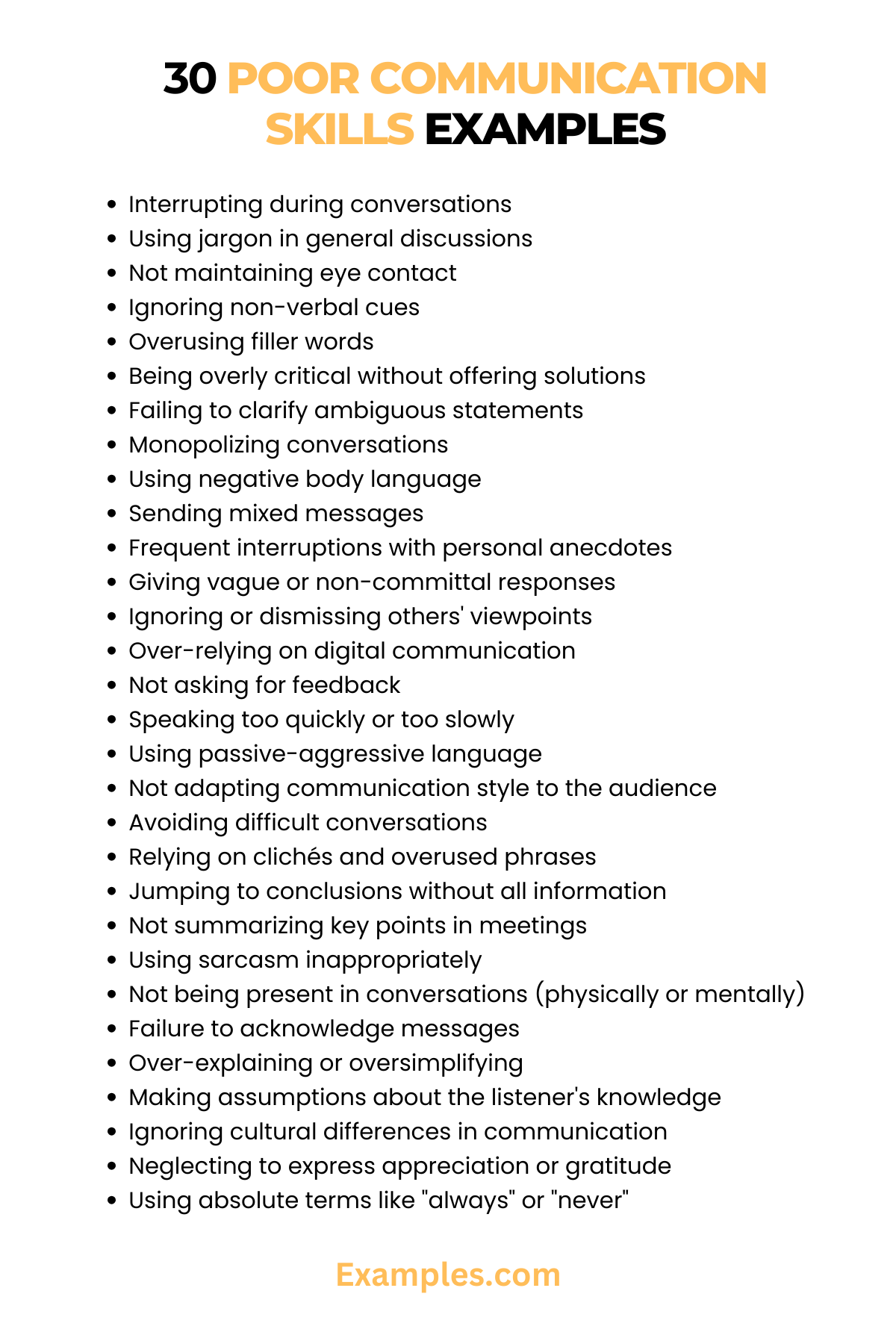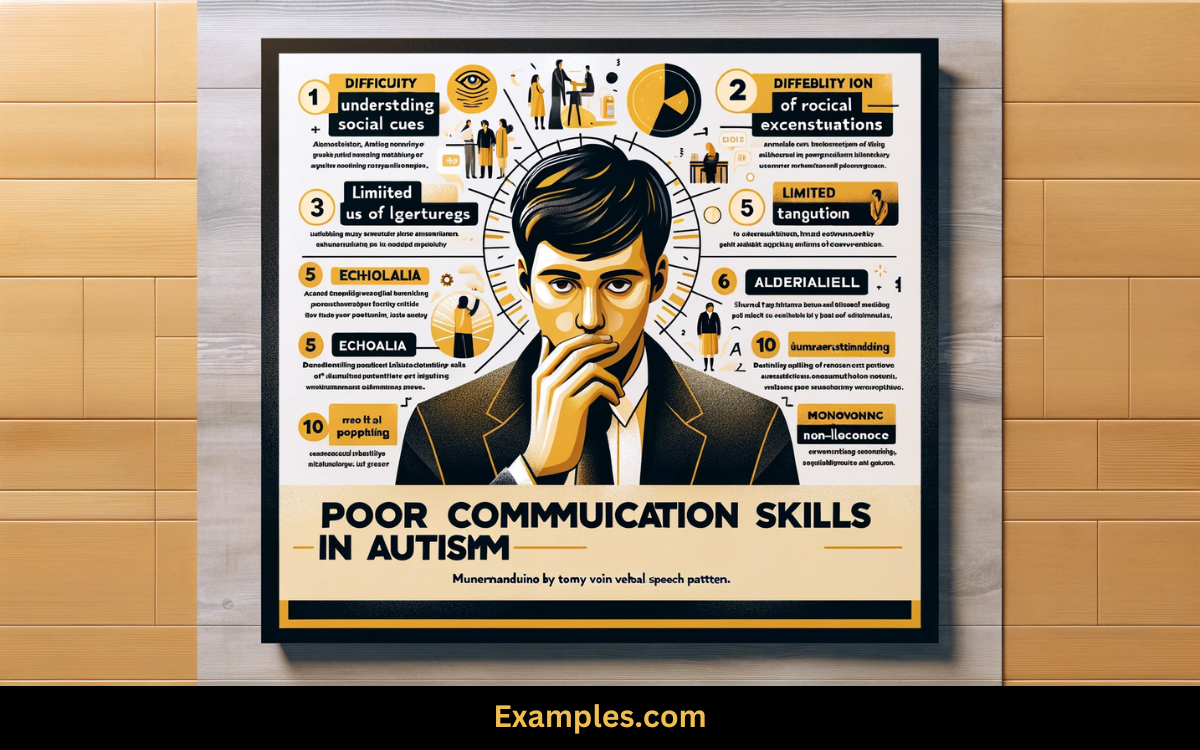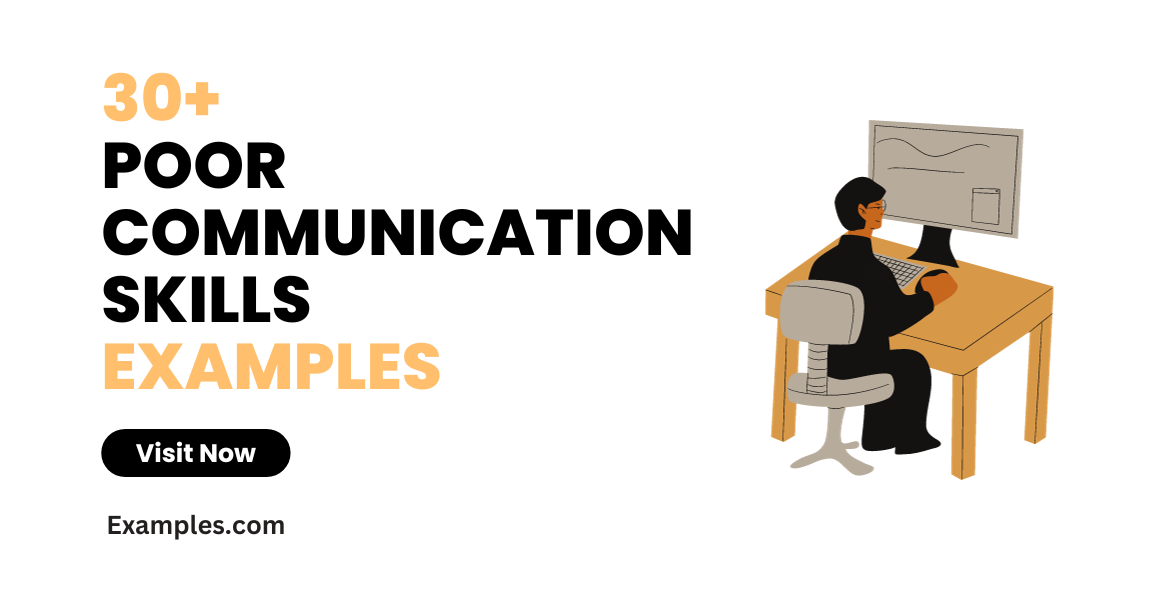29+ Poor Communication Skills Examples
Discover the essential guide to understanding and overcoming poor communication skills, complete with insightful sentence examples. In a world where effective interaction is key, this comprehensive guide delves into the nuances of communication, highlighting common pitfalls and offering practical solutions. From workplace scenarios to personal relationships, we explore various communication examples, demonstrating how subtle missteps can lead to misunderstandings. Whether you’re a professional, student, or simply someone looking to improve your interpersonal skills, this guide is an invaluable resource for mastering the art of clear and positive communication.
30 Poor Communication Skills Examples
Embark on a journey through 30 distinct examples of poor communication skills, each vividly illustrating the nuances and consequences of ineffective interaction. This enlightening collection not only highlights common communication missteps but also provides valuable insights into how each can be rectified. From misunderstandings in professional settings to miscommunication in personal relationships, these examples serve as a practical guide for anyone looking to enhance their communication prowess. Each scenario is accompanied by a two-line explanation, offering a clear contrast between poor communication and its effective counterpart. This resource is essential for developing strong, clear, and empathetic communication strategies in various aspects of life.

- Interrupting during conversations: Constantly interrupting signals disrespect and hinders understanding. Instead, practice active listening and respond thoughtfully after the speaker finishes.
- Using jargon in general discussions: Overuse of technical language can confuse and alienate listeners. Aim for clear and simple language that everyone can understand.
- Not maintaining eye contact: Avoiding eye contact can appear disinterested or dishonest. Maintain appropriate eye contact to show engagement and sincerity.
- Ignoring non-verbal cues: Missing non-verbal signals leads to misinterpretation. Pay attention to body language and facial expressions for a complete understanding.
- Overusing filler words: Excessive use of “um,” “like,” and “you know” can distract and undermine your message. Practice speaking clearly and concisely to convey confidence.
- Being overly critical without offering solutions: Constant criticism without constructive feedback can demoralize and confuse. Provide balanced feedback with actionable suggestions.
- Failing to clarify ambiguous statements: Vague language leads to misunderstandings. Clarify your points to ensure accurate comprehension.
- Monopolizing conversations: Dominating talk time prevents others from contributing. Encourage a balanced dialogue where all voices are heard.
- Using negative body language: Crossing arms or frowning can convey disinterest or hostility. Adopt open and positive body language to foster a welcoming environment.
- Sending mixed messages: Contradictory verbal and non-verbal communication creates confusion. Ensure your words and actions align to convey a clear message.
- Frequent interruptions with personal anecdotes: Derailing conversations with personal stories hinders topic progression. Stay focused on the subject at hand and share personal experiences when relevant.
- Giving vague or non-committal responses: Indecisive answers lead to uncertainty and lack of trust. Be clear and decisive in your responses.
- Ignoring or dismissing others’ viewpoints: Disregarding others’ opinions can create resentment and stifle collaboration. Acknowledge and consider different perspectives.
- Over-relying on digital communication: Excessive emailing or texting can lack personal touch and lead to misinterpretation. Balance digital communication with face-to-face interactions.
- Not asking for feedback: Failure to seek feedback can hinder growth and understanding. Regularly ask for and act on feedback to improve communication.
- Speaking too quickly or too slowly: Extreme speaking speeds can either overwhelm or bore the listener. Moderate your pace for clarity and engagement.
- Using passive-aggressive language: Such language can be confusing and damaging to relationships. Communicate openly and directly.
- Not adapting communication style to the audience: A one-size-fits-all approach can lead to disengagement. Tailor your communication style to suit different audiences.
- Avoiding difficult conversations: Evading tough topics can lead to unresolved issues. Approach difficult conversations with honesty and empathy.
- Relying on clichés and overused phrases: This can make communication seem insincere or unoriginal. Use fresh and genuine language to express your thoughts.
- Jumping to conclusions without all information: This leads to misunderstandings and rash decisions. Gather all necessary information before forming conclusions.
- Not summarizing key points in meetings: Failure to recap can lead to confusion about action items. Summarize main points and next steps at the end of meetings.
- Using sarcasm inappropriately: Sarcasm can be misinterpreted and hurtful. Use clear and straightforward language, especially in professional settings.
- Not being present in conversations (physically or mentally): This indicates disinterest and disrespect. Engage fully with your conversation partner.
- Failure to acknowledge messages: Not responding to emails or texts can imply ignorance or disrespect. Acknowledge received messages in a timely manner.
- Over-explaining or oversimplifying: This can either confuse or patronize the audience. Aim for clarity and conciseness appropriate to the listener’s level of understanding.
- Making assumptions about the listener’s knowledge: This can lead to miscommunication or offense. Assess the listener’s background knowledge and communicate accordingly.
- Ignoring cultural differences in communication: This can lead to misunderstandings and offense. Be mindful of and adapt to cultural communication norms.
- Neglecting to express appreciation or gratitude: This omission can demotivate and create a negative atmosphere. Regularly express sincere appreciation and gratitude.
- Using absolute terms like “always” or “never”: These can lead to generalizations and misunderstandings. Use more precise language to accurately convey your message.
Poor Communication Skills in the Workplace
Explore the critical impact of poor communication skills within a workplace setting. This detailed analysis highlights ten specific examples, each illustrating a unique communication challenge that professionals often encounter. By understanding these pitfalls, individuals can enhance their workplace interactions, fostering a more productive and positive environment. Each example is bolstered with a concise explanation, demonstrating the contrast between ineffective communication and strategies for improvement. This guide is invaluable for anyone aiming to excel in their professional communication skills.

- Overlooking the importance of regular team updates Failing to keep team members informed can lead to confusion and missed opportunities. Establish a routine for regular updates to ensure everyone is on the same page.
- Not providing clear instructions Ambiguous directives can result in errors and wasted effort. Offer detailed, step-by-step instructions and be available for any clarifications.
- Ignoring emails or messages from colleagues Neglecting communication from team members can create a sense of disregard. Make it a habit to promptly respond to or acknowledge received messages.
- Avoiding giving constructive feedback Withholding feedback can hinder team growth and development. Provide regular, constructive feedback to help team members improve and succeed.
- Failing to actively listen during meetings Not paying full attention in meetings can lead to misunderstandings. Practice active listening, showing engagement and understanding of the discussions.
- Resorting to technical jargon with non-expert colleagues Using overly technical language can alienate or confuse non-specialist team members. Use clear, accessible language when discussing specialized topics.
- Not respecting cultural and linguistic diversity Ignoring these aspects can lead to miscommunication and discomfort. Show respect for and adapt to the diverse cultural and linguistic backgrounds of colleagues.
- Undermining colleagues in group discussions This creates a hostile environment and damages team morale. Foster a respectful and inclusive discussion space where all opinions are valued.
- Neglecting the importance of body language in communication Non-verbal cues play a significant role in conveying messages. Be aware of your body language and ensure it aligns with your verbal communication.
- Failing to confirm understanding after communications Assumptions can lead to errors and inefficiencies. Always confirm that your message has been understood as intended, especially in crucial communications.
Effects of Poor Communication Skills Among Students
Delve into the profound effects of poor communication skills on students’ academic and social lives. This detailed exploration sheds light on ten unique challenges students face due to ineffective communication, highlighting how these issues can hinder their educational journey and interpersonal relationships. Each example is accompanied by an explanation and practical advice for improvement, making this an essential resource for educators, parents, and students alike. Understanding and addressing these communication barriers can significantly enhance students’ overall learning experience and personal growth.

- Struggling with group projects Poor communication can lead to misunderstandings and conflicts in group assignments. Encourage open dialogue and regular check-ins to ensure everyone is on the same page.
- Difficulty in understanding complex concepts Inadequate communication skills can hinder comprehension of intricate subjects. Seek clarification and ask questions to gain a deeper understanding.
- Failing to express needs and concerns to teachers Not voicing concerns can result in unresolved issues. Practice articulating thoughts clearly and respectfully to teachers.
- Inability to effectively participate in class discussions Poor communication can limit engagement in classroom dialogue. Prepare points in advance and practice speaking up in a supportive environment.
- Misinterpreting assignment instructions Misunderstanding instructions can lead to poor academic performance. Always confirm understanding of tasks and ask for examples if needed.
- Difficulty in forming study groups Ineffective communication can hinder the formation of collaborative study teams. Initiate conversations with classmates and clearly express the intent to form study groups.
- Challenges in resolving conflicts with peers Poor communication often exacerbates conflicts. Learn to listen actively and express viewpoints calmly to resolve disputes amicably.
- Struggling to build relationships with peers Inadequate communication skills can impede forming friendships. Engage in open, friendly conversations and show genuine interest in others.
- Difficulty in presenting ideas during presentations Ineffective communication can affect the quality of presentations. Practice presenting in front of peers or family to gain confidence.
- Feeling isolated due to inability to connect with others Poor communication can lead to feelings of loneliness and isolation. Seek opportunities to interact in group activities and improve social communication skills.
Poor Communication Skills in Autism
Dive into the complexities of communication challenges faced by individuals with autism. This detailed exploration presents ten unique examples of communication difficulties commonly observed in autism, offering insights and strategies for effective interaction. Each example is enriched with an explanation and an alternative approach to foster clearer communication. This guide is an invaluable resource for educators, caregivers, and individuals seeking to better understand and support effective communication in those with autism.

- Difficulty in understanding social cues Individuals with autism might struggle to interpret social signals. Use clear, direct language and avoid sarcasm or idioms.
- Avoiding eye contact Eye contact can be uncomfortable for some with autism. Respect their comfort level and focus on verbal communication instead.
- Literal interpretation of language They may take words and phrases at face value. Be specific and avoid using figurative language or metaphors.
- Echolalia (repeating words or phrases) Echolalia is common but can hinder conversation flow. Gently guide them back to the topic and encourage original responses.
- Limited use of gestures or facial expressions This can make their communication seem flat or unengaged. Encourage the use of visual aids or alternative communication methods.
- Difficulty in initiating or sustaining conversations Starting or maintaining a dialogue can be challenging. Provide prompts and topics of interest to help them engage.
- Taking turns in conversation They might struggle with back-and-forth aspects of talking. Practice turn-taking in conversations with clear cues for when it’s their turn to speak.
- Monotone or robotic speech pattern This can affect the emotional depth of communication. Work on varying tone and pitch to express different emotions.
- Overwhelm by too much verbal information Information overload can lead to communication breakdown. Keep verbal instructions clear, concise, and delivered in smaller segments.
- Misunderstanding non-literal language Difficulty in grasping sarcasm, jokes, or idioms is common. Explain the intended meaning of non-literal phrases when necessary.
How Do You Deal with Poor Communication Skills?
Improving communication skills is vital for personal and professional success. Dealing with poor communication skills involves self-awareness, willingness to learn, and consistent practice. Begin by identifying the specific areas where your communication could improve. Are you often misunderstood, or do you find it challenging to express your thoughts clearly? Once you’ve pinpointed these areas, take proactive steps to enhance your skills.
Engaging in active listening is crucial. This means fully concentrating on the speaker, understanding their message, and responding thoughtfully. Active listening helps in building stronger relationships and reduces misunderstandings. Another key aspect is to work on your non-verbal communication. Body language, eye contact, and facial expressions play a significant role in how your message is received.
Additionally, consider enrolling in communication skills workshops or training sessions. These can provide valuable insights and practical techniques to improve your communication. Seeking feedback from others can also be beneficial. Ask colleagues, friends, or family for honest feedback on your communication style and areas for improvement.
Finally, practice makes perfect. Implement the techniques you learn in your daily interactions. Be patient with yourself, as developing strong communication skills takes time and effort.
How Do You Address Poor Communication at Work?
Addressing poor communication in the workplace is essential for maintaining a productive and harmonious environment. The first step is to identify the root causes of communication breakdowns. Is it due to a lack of clear instructions, cultural differences, or perhaps technological barriers? Once identified, tailored strategies can be implemented to overcome these challenges.
For leaders and managers, setting clear expectations regarding communication is key. This could involve establishing guidelines for email communications, regular team meetings, and one-on-one check-ins. Encouraging an open-door policy where employees feel comfortable voicing their concerns and suggestions can also improve communication.
In situations where specific individuals exhibit poor communication skills, providing constructive feedback is important. This should be done in a supportive and non-confrontational manner. Highlight specific instances where communication was an issue and offer clear, actionable advice on how they can improve.
Another effective strategy is to foster a culture of active listening within the team. Encourage team members to listen attentively to one another and show respect for different viewpoints. This not only improves communication but also boosts team morale and collaboration.
Implementing team-building activities can also enhance communication skills. These activities can break down barriers and improve understanding among team members.
Lastly, consider providing communication skills training for your team. Professional development in this area can benefit all levels of staff and lead to more effective and efficient workplace communication.
29+ Poor Communication Skills Examples

Discover the essential guide to understanding and overcoming poor communication skills, complete with insightful sentence examples. In a world where effective interaction is key, this comprehensive guide delves into the nuances of communication, highlighting common pitfalls and offering practical solutions. From workplace scenarios to personal relationships, we explore various communication examples, demonstrating how subtle missteps can lead to misunderstandings. Whether you’re a professional, student, or simply someone looking to improve your interpersonal skills, this guide is an invaluable resource for mastering the art of clear and positive communication.
30 Poor Communication Skills Examples
Embark on a journey through 30 distinct examples of poor communication skills, each vividly illustrating the nuances and consequences of ineffective interaction. This enlightening collection not only highlights common communication missteps but also provides valuable insights into how each can be rectified. From misunderstandings in professional settings to miscommunication in personal relationships, these examples serve as a practical guide for anyone looking to enhance their communication prowess. Each scenario is accompanied by a two-line explanation, offering a clear contrast between poor communication and its effective counterpart. This resource is essential for developing strong, clear, and empathetic communication strategies in various aspects of life.

Interrupting during conversations: Constantly interrupting signals disrespect and hinders understanding. Instead, practice active listening and respond thoughtfully after the speaker finishes.
Using jargon in general discussions: Overuse of technical language can confuse and alienate listeners. Aim for clear and simple language that everyone can understand.
Not maintaining eye contact: Avoiding eye contact can appear disinterested or dishonest. Maintain appropriate eye contact to show engagement and sincerity.
Ignoring non-verbal cues: Missing non-verbal signals leads to misinterpretation. Pay attention to body language and facial expressions for a complete understanding.
Overusing filler words: Excessive use of “um,” “like,” and “you know” can distract and undermine your message. Practice speaking clearly and concisely to convey confidence.
Being overly critical without offering solutions: Constant criticism without constructive feedback can demoralize and confuse. Provide balanced feedback with actionable suggestions.
Failing to clarify ambiguous statements: Vague language leads to misunderstandings. Clarify your points to ensure accurate comprehension.
Monopolizing conversations: Dominating talk time prevents others from contributing. Encourage a balanced dialogue where all voices are heard.
Using negative body language: Crossing arms or frowning can convey disinterest or hostility. Adopt open and positive body language to foster a welcoming environment.
Sending mixed messages: Contradictory verbal and non-verbal communication creates confusion. Ensure your words and actions align to convey a clear message.
Frequent interruptions with personal anecdotes: Derailing conversations with personal stories hinders topic progression. Stay focused on the subject at hand and share personal experiences when relevant.
Giving vague or non-committal responses: Indecisive answers lead to uncertainty and lack of trust. Be clear and decisive in your responses.
Ignoring or dismissing others’ viewpoints: Disregarding others’ opinions can create resentment and stifle collaboration. Acknowledge and consider different perspectives.
Over-relying on digital communication: Excessive emailing or texting can lack personal touch and lead to misinterpretation. Balance digital communication with face-to-face interactions.
Not asking for feedback: Failure to seek feedback can hinder growth and understanding. Regularly ask for and act on feedback to improve communication.
Speaking too quickly or too slowly: Extreme speaking speeds can either overwhelm or bore the listener. Moderate your pace for clarity and engagement.
Using passive-aggressive language: Such language can be confusing and damaging to relationships. Communicate openly and directly.
Not adapting communication style to the audience: A one-size-fits-all approach can lead to disengagement. Tailor your communication style to suit different audiences.
Avoiding difficult conversations: Evading tough topics can lead to unresolved issues. Approach difficult conversations with honesty and empathy.
Relying on clichés and overused phrases: This can make communication seem insincere or unoriginal. Use fresh and genuine language to express your thoughts.
Jumping to conclusions without all information: This leads to misunderstandings and rash decisions. Gather all necessary information before forming conclusions.
Not summarizing key points in meetings: Failure to recap can lead to confusion about action items. Summarize main points and next steps at the end of meetings.
Using sarcasm inappropriately: Sarcasm can be misinterpreted and hurtful. Use clear and straightforward language, especially in professional settings.
Not being present in conversations (physically or mentally): This indicates disinterest and disrespect. Engage fully with your conversation partner.
Failure to acknowledge messages: Not responding to emails or texts can imply ignorance or disrespect. Acknowledge received messages in a timely manner.
Over-explaining or oversimplifying: This can either confuse or patronize the audience. Aim for clarity and conciseness appropriate to the listener’s level of understanding.
Making assumptions about the listener’s knowledge: This can lead to miscommunication or offense. Assess the listener’s background knowledge and communicate accordingly.
Ignoring cultural differences in communication: This can lead to misunderstandings and offense. Be mindful of and adapt to cultural communication norms.
Neglecting to express appreciation or gratitude: This omission can demotivate and create a negative atmosphere. Regularly express sincere appreciation and gratitude.
Using absolute terms like “always” or “never”: These can lead to generalizations and misunderstandings. Use more precise language to accurately convey your message.
Poor Communication Skills in the Workplace
Explore the critical impact of poor communication skills within a workplace setting. This detailed analysis highlights ten specific examples, each illustrating a unique communication challenge that professionals often encounter. By understanding these pitfalls, individuals can enhance their workplace interactions, fostering a more productive and positive environment. Each example is bolstered with a concise explanation, demonstrating the contrast between ineffective communication and strategies for improvement. This guide is invaluable for anyone aiming to excel in their professional communication skills.

Overlooking the importance of regular team updates Failing to keep team members informed can lead to confusion and missed opportunities. Establish a routine for regular updates to ensure everyone is on the same page.
Not providing clear instructions Ambiguous directives can result in errors and wasted effort. Offer detailed, step-by-step instructions and be available for any clarifications.
Ignoring emails or messages from colleagues Neglecting communication from team members can create a sense of disregard. Make it a habit to promptly respond to or acknowledge received messages.
Avoiding giving constructive feedback Withholding feedback can hinder team growth and development. Provide regular, constructive feedback to help team members improve and succeed.
Failing to actively listen during meetings Not paying full attention in meetings can lead to misunderstandings. Practice active listening, showing engagement and understanding of the discussions.
Resorting to technical jargon with non-expert colleagues Using overly technical language can alienate or confuse non-specialist team members. Use clear, accessible language when discussing specialized topics.
Not respecting cultural and linguistic diversity Ignoring these aspects can lead to miscommunication and discomfort. Show respect for and adapt to the diverse cultural and linguistic backgrounds of colleagues.
Undermining colleagues in group discussions This creates a hostile environment and damages team morale. Foster a respectful and inclusive discussion space where all opinions are valued.
Neglecting the importance of body language in communication Non-verbal cues play a significant role in conveying messages. Be aware of your body language and ensure it aligns with your verbal communication.
Failing to confirm understanding after communications Assumptions can lead to errors and inefficiencies. Always confirm that your message has been understood as intended, especially in crucial communications.
Effects of Poor Communication Skills Among Students
Delve into the profound effects of poor communication skills on students’ academic and social lives. This detailed exploration sheds light on ten unique challenges students face due to ineffective communication, highlighting how these issues can hinder their educational journey and interpersonal relationships. Each example is accompanied by an explanation and practical advice for improvement, making this an essential resource for educators, parents, and students alike. Understanding and addressing these communication barriers can significantly enhance students’ overall learning experience and personal growth.

Struggling with group projects Poor communication can lead to misunderstandings and conflicts in group assignments. Encourage open dialogue and regular check-ins to ensure everyone is on the same page.
Difficulty in understanding complex concepts Inadequate communication skills can hinder comprehension of intricate subjects. Seek clarification and ask questions to gain a deeper understanding.
Failing to express needs and concerns to teachers Not voicing concerns can result in unresolved issues. Practice articulating thoughts clearly and respectfully to teachers.
Inability to effectively participate in class discussions Poor communication can limit engagement in classroom dialogue. Prepare points in advance and practice speaking up in a supportive environment.
Misinterpreting assignment instructions Misunderstanding instructions can lead to poor academic performance. Always confirm understanding of tasks and ask for examples if needed.
Difficulty in forming study groups Ineffective communication can hinder the formation of collaborative study teams. Initiate conversations with classmates and clearly express the intent to form study groups.
Challenges in resolving conflicts with peers Poor communication often exacerbates conflicts. Learn to listen actively and express viewpoints calmly to resolve disputes amicably.
Struggling to build relationships with peers Inadequate communication skills can impede forming friendships. Engage in open, friendly conversations and show genuine interest in others.
Difficulty in presenting ideas during presentations Ineffective communication can affect the quality of presentations. Practice presenting in front of peers or family to gain confidence.
Feeling isolated due to inability to connect with others Poor communication can lead to feelings of loneliness and isolation. Seek opportunities to interact in group activities and improve social communication skills.
Poor Communication Skills in Autism
Dive into the complexities of communication challenges faced by individuals with autism. This detailed exploration presents ten unique examples of communication difficulties commonly observed in autism, offering insights and strategies for effective interaction. Each example is enriched with an explanation and an alternative approach to foster clearer communication. This guide is an invaluable resource for educators, caregivers, and individuals seeking to better understand and support effective communication in those with autism.

Difficulty in understanding social cues Individuals with autism might struggle to interpret social signals. Use clear, direct language and avoid sarcasm or idioms.
Avoiding eye contact Eye contact can be uncomfortable for some with autism. Respect their comfort level and focus on verbal communication instead.
Literal interpretation of language They may take words and phrases at face value. Be specific and avoid using figurative language or metaphors.
Echolalia (repeating words or phrases) Echolalia is common but can hinder conversation flow. Gently guide them back to the topic and encourage original responses.
Limited use of gestures or facial expressions This can make their communication seem flat or unengaged. Encourage the use of visual aids or alternative communication methods.
Difficulty in initiating or sustaining conversations Starting or maintaining a dialogue can be challenging. Provide prompts and topics of interest to help them engage.
Taking turns in conversation They might struggle with back-and-forth aspects of talking. Practice turn-taking in conversations with clear cues for when it’s their turn to speak.
Monotone or robotic speech pattern This can affect the emotional depth of communication. Work on varying tone and pitch to express different emotions.
Overwhelm by too much verbal information Information overload can lead to communication breakdown. Keep verbal instructions clear, concise, and delivered in smaller segments.
Misunderstanding non-literal language Difficulty in grasping sarcasm, jokes, or idioms is common. Explain the intended meaning of non-literal phrases when necessary.
How Do You Deal with Poor Communication Skills?
Improving communication skills is vital for personal and professional success. Dealing with poor communication skills involves self-awareness, willingness to learn, and consistent practice. Begin by identifying the specific areas where your communication could improve. Are you often misunderstood, or do you find it challenging to express your thoughts clearly? Once you’ve pinpointed these areas, take proactive steps to enhance your skills.
Engaging in active listening is crucial. This means fully concentrating on the speaker, understanding their message, and responding thoughtfully. Active listening helps in building stronger relationships and reduces misunderstandings. Another key aspect is to work on your non-verbal communication. Body language, eye contact, and facial expressions play a significant role in how your message is received.
Additionally, consider enrolling in communication skills workshops or training sessions. These can provide valuable insights and practical techniques to improve your communication. Seeking feedback from others can also be beneficial. Ask colleagues, friends, or family for honest feedback on your communication style and areas for improvement.
Finally, practice makes perfect. Implement the techniques you learn in your daily interactions. Be patient with yourself, as developing strong communication skills takes time and effort.
How Do You Address Poor Communication at Work?
Addressing poor communication in the workplace is essential for maintaining a productive and harmonious environment. The first step is to identify the root causes of communication breakdowns. Is it due to a lack of clear instructions, cultural differences, or perhaps technological barriers? Once identified, tailored strategies can be implemented to overcome these challenges.
For leaders and managers, setting clear expectations regarding communication is key. This could involve establishing guidelines for email communications, regular team meetings, and one-on-one check-ins. Encouraging an open-door policy where employees feel comfortable voicing their concerns and suggestions can also improve communication.
In situations where specific individuals exhibit poor communication skills, providing constructive feedback is important. This should be done in a supportive and non-confrontational manner. Highlight specific instances where communication was an issue and offer clear, actionable advice on how they can improve.
Another effective strategy is to foster a culture of active listening within the team. Encourage team members to listen attentively to one another and show respect for different viewpoints. This not only improves communication but also boosts team morale and collaboration.
Implementing team-building activities can also enhance communication skills. These activities can break down barriers and improve understanding among team members.
Lastly, consider providing communication skills training for your team. Professional development in this area can benefit all levels of staff and lead to more effective and efficient workplace communication.


